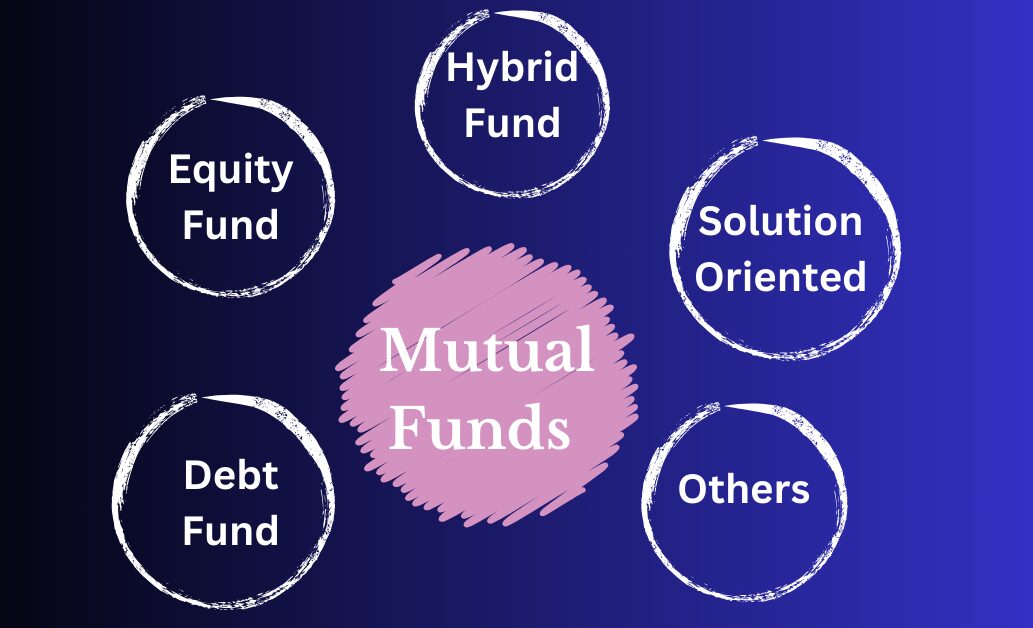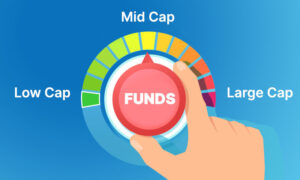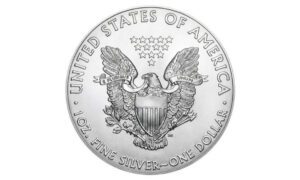Mutual funds are one the best investment options in a growing market like the UAE. It often delivers higher returns than traditional bank deposits.
For example:
High-quality fixed deposits offer about 3.8% interest in a year. In contrast, equity-based mutual funds in UAE commonly deliver 8 to 10% or more over the long term.
But remember one thing.
The return you earn from mutual funds depend directly on the type of fund you choose. For instance, equity funds are risky but they nearly give 2x better returns when compared to lower risk debt funds.
This brings us to the first rule of mutual funds investment – “Understand the different fund types before you lock in your money.”
In this blog, we’ll explain the different types of mutual funds based on various categories and also share tips to help you choose the right ones.

Types of mutual funds
Ideally, there are four main types of mutual funds – equity, debt, hybrid, and money market. But there are many other sub-categories as well. That’s why we are dividing them based on the following:
- Asset class
- Investment goal
- Structure
- Risk
- Specialized purpose
A. Types of mutual funds based on asset class
One of the easiest ways to understand mutual funds is by looking at the type of assets they invest in. These assets could be stocks, bonds, or even a mix of both.
Equity mutual funds
Good for: Investors who want higher returns and can handle market ups and downs.
Risk level: High
Returns: Around 10% or more – depending on the market
Equity funds invest mainly in shares of companies. These funds aim to grow your money over time by tapping into the stock market. They are the best mutual funds for long-term goals like retirement or building wealth.If you’d like to explore them further, here’s a detailed guide on equity funds and how they work.
Common types of equity funds
- Large-cap funds: Invest in big and stable companies
- Mid-cap and small-cap funds: Focus on growing companies with more risk
- Index funds: Track a stock market index like the S&P 500
- Sector funds: Invest in specific industries like tech or healthcare
Debt mutual funds
Good for: Conservative investors or short-term goals
Risk level: Low to moderate
Returns: Typically 4–6%
Debt funds invest in fixed-income instruments like government bonds, corporate bonds, or treasury bills. They don’t offer high returns like equity funds, but they are more stable.
Common types of debt funds
- Corporate bond funds: Invest in company-issued bonds
- Government bond funds: Safer but lower return
- Liquid and money market funds: Short-term with low-risk options
Hybrid mutual funds
Good for: Medium-risk investors looking for a mix of growth and protection
Risk level: Moderate
Returns: Between equity and debt averages
Hybrid funds invest in both equity and debt. The goal is to balance growth and safety. Some hybrid funds lean more towards stocks, while others focus more on bonds.
Types of hybrid funds
- Aggressive hybrid funds: More equity and more growth
- Conservative hybrid funds: More debt and more stability
- Balanced advantage funds: Shift between equity and debt based on market conditions
Money market funds
Good for: Emergency funds or short-term savings
Risk level: Very low
Returns: 3 to 4% but stable
These funds invest in very short-term debt instruments like treasury bills or certificates of deposit. They are used to park money for a short period while keeping it safe.

B. Types of mutual funds based on investment objective
Every mutual fund is built with a goal in mind. Some are designed to grow your money fast. Others aim to give you regular income or preserve your capital.
Growth funds
These focus on capital appreciation by investing in stocks of companies expected to grow quickly. You may not get regular income, but your money has the potential to grow more over time. Growth funds are best for long-term wealth building but the risk is high. The returns are often 10% or more.
Income funds
These aim to give you regular payouts through interest or dividends. They mostly invest in debt instruments or dividend-paying stocks. Retirees or anyone who wants stable income should invest in income funds because the risk is low to moderate. You can expect 4 to 6% returns or sometimes slightly more.
Liquid funds
These focus on safety and easy access to money. They invest in short-term debt and are better than leaving cash idle in a savings account. Liquid funds are good for parking money short-term or building an emergency fund. The risk is very low and returns are steady, around 3 to 4%.
Capital protection funds
These are designed to protect your original investment while giving some returns. They mostly invest in debt with a small equity exposure. Cautious investors can opt for these funds because of lower risk.
Aggressive growth funds
These go for high returns by investing in small-cap and high-growth stocks. The goal is fast growth, but they come with higher risk. These funds are ideal for young investors with long-term goals. The risk is high, but you can earn above 12% returns.
Pension/retirement funds
These help you build a retirement corpus. They start with high equity exposure and gradually shift to safer assets as you near retirement. Pension funds are good for long-term retirement planning. But remember that the risk can change over time and the returns can be usually moderate to high.
C. Types of mutual funds based on structure
Mutual funds can also be grouped by how flexible they are when it comes to buying and selling. This matters if you want the freedom to access your money, or if you are okay with locking it in for a while.
Open-ended funds
Open-ended funds let you invest or withdraw your money at any time. There is no maturity period, and you buy units based on the fund’s current NAV (Net Asset Value). Most mutual funds available today fall under this category because they are flexible and easy to manage for regular investors.
Close-ended funds
Close-ended funds have a fixed maturity period. You can invest only during the initial offer period. Once that window closes, no new investments are allowed. If you want to exit early, you will need to sell your units on the stock exchange, which may or may not be easy depending on market demand.
Interval funds
These are a mix of both. They open for buying and selling only at specific times, like every 6 months or once a year. These are less common but may appeal to investors looking for a balance between liquidity and discipline.
D. Types of mutual funds based on risk
Every mutual fund comes with some level of risk. Understanding this helps you avoid surprises and choose a fund that matches how comfortable you are with market ups and downs.
Very low-risk funds
They usually include liquid and money market funds. These invest in short-term government securities or high-quality debt instruments. They are unlikely to give high returns but are very stable.
Low-risk funds
Low-risk funds include most government bond funds and capital protection funds. They are ideal for conservative investors who prefer steady returns without much fluctuation. The returns are modest, but your capital is largely safe.
Medium-risk funds
Medium-risk funds typically include hybrid funds – especially those with a balanced mix of equity and debt. They offer better growth than low-risk funds but carry more volatility. These are great for people who want some exposure to equity without taking full stock market risk.
High-risk funds
These are usually equity-based, especially those that invest in small-cap companies or specific sectors like tech or energy. These funds can rise or fall quickly depending on market conditions. They are suitable for long-term investors who are comfortable with risk and want the potential for higher returns.
E. Specialized mutual funds
These mutual funds don’t fit into the usual categories but serve very specific investment needs. They are ideal for investors who have a clear goal or strategy in mind.
Shariah-compliant funds
Shariah-compliant funds follow Islamic investment principles. They avoid businesses related to alcohol, gambling, interest-based finance, and other restricted sectors. These funds are popular among Muslim investors in the UAE and often include a mix of halal equities and sukuk (Islamic bonds).
Sukuk funds
These funds invest in Shariah-compliant fixed-income products. They offer a steady income stream like regular bond funds but align with Islamic finance rules. Sukuk funds are useful for conservative investors who prefer ethical investing.
Sector or thematic funds
Sector funds focus on a specific industry or theme – like technology, healthcare, energy, or ESG (environmental, social, and governance). These funds can grow fast when that sector performs well but can also fall quickly if that sector slows down.
Target date funds
They are designed for a specific future goal, usually retirement. The fund automatically shifts from high-risk investments to safer ones as the target year gets closer. It is a hands-off way to plan long-term.
Fund of funds
Fund of funds invest in other mutual funds instead of stocks or bonds directly. This gives you diversification in one single fund but may come with higher fees.
International or global funds
International fundsinvest outside your home country. These help diversify your money across different economies and currencies, which can reduce risk and open up more opportunities.

How to choose the right mutual fund for you?
Choosing a mutual fund is not about picking the one with the highest return. It is about picking the one that actually fits your financial situation and comfort with risk.
Start by asking yourself a few simple questions.
What are you investing for?
If it is long-term growth, equity funds may work well. If it is steady income, debt or income funds are a better fit.
How long can you stay invested?
If you need your money in a year, avoid high-risk funds. For longer goals, you can afford to ride out short-term market changes.
How much risk are you okay with?
If market ups and downs stress you out, go for something safer like hybrid or debt funds. If you can stay calm through market swings, equity funds may reward you more over time.
Pro tip
You can also use a mutual fund calculator to compare potential returns based on how much you invest and for how long. It is a simple tool that helps you set realistic expectations.
Where and how to invest in mutual funds online in UAE?
Investing in mutual funds in the UAE has become easy and fully online. You no longer need to visit a bank or fill out long forms. Many banks and financial institutions now offer digital platforms where you can explore, compare, and invest in mutual funds online with just a few clicks.
For example, platforms like Standard Chartered UAE allow you to invest directly in a wide range of global and regional funds. You can browse different categories, check past performance, and choose funds based on your goals. Most platforms support online KYC, so you can start investing without leaving home.
You will also find features like SIPs (Systematic Investment Plans) that let you invest a fixed amount every month, as well as tracking tools to monitor your fund’s performance.
FAQs
What is a mutual fund?
A mutual fund is a way to invest your money with others into a pool that is managed by professionals. That money is then invested in things like stocks, bonds, or a mix of both. You don’t have to pick individual shares or track the market daily – the fund manager does that for you.
What are the best mutual funds for beginners in the UAE?
The best mutual funds for beginners usually include balanced or hybrid funds because they offer a mix of growth and safety. If you are just starting, look for mutual funds in UAE that allow small investments and are easy to manage online.
How can I invest in mutual funds online in the UAE?
You can invest in mutual funds online through banks like Standard Chartered UAE or investment platforms that offer global and Shariah-compliant options
What are the top mutual funds for long-term growth?
Top mutual funds for long-term growth are usually equity funds that invest in large-cap or diversified global stocks. Index funds like S&P 500 or thematic funds focused on technology and healthcare are also popular choices among UAE investors.
How much money do I need to start investing in mutual funds in UAE?
Most mutual funds in UAE allow you to start with as little as AED 500 to AED 1,000. Some platforms even offer monthly investment options through SIPs.



































